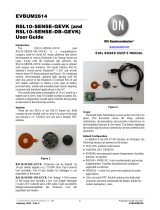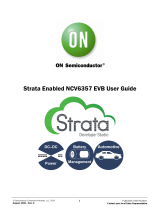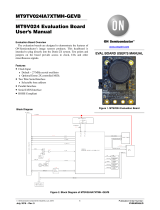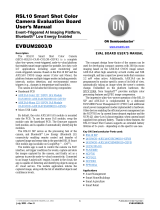Page is loading ...

© Semiconductor Components Industries, LLC, 2019
August, 2019 − Rev. 1
1Publication Order Number:
EVBUM2623/D
EVBUM2623/D
RSL10 Solar Cell
Multi-Sensor Platform
User's Guide
Introduction
The RSL10 Solar Cell Multi−Sensor Platform
(RSL10−SOLARSENS−GEVK) is a comprehensive development
platform for battery−free IoT applications for smart building, smart
home, and Industry 4.0 verticals. Based on the industry’s lowest power
Bluetooth® Low Energy radio (RSL10), the board features sensors for
environmental and motion sensing (BMA400−a smart 3−axis
accelerometer, BME280− a smart environmental sensor, and the
NCT203 wide−range digital temperature sensor).
The board also features a low weight, low profile 47 mF storage
capacitor of; a programming and debug interface; and a connected
solar cell.
Since the device harvests energy from a low current source, it is
important to minimize leakage of the overall system during operation
and standby. Along with other energy efficient devices, an ultra−low
quiescent current LDO (NCP170) on the board significantly minimize
leakage.
Figure 1. RSL10 Solar Cell Multi−Sensor Platform
EVAL BOARD USER’S MANUAL
www.onsemi.com

EVBUM2623/D
www.onsemi.com
2
Hardware Description
Default Configuration
The development platform includes a solar multi-sensor
board hardware and a connected solar cell. If you need to
reconnect the solar cell or would like to work with another
solar cell than the one provided out of the box, follow the
guidelines in section ‘Powering the Board’.
In addition to the RSL10 SIP (System−in−Package), the
following sensors are present on the board.
•BMA400, 3−Axis Smart Accelerometer
•BME280, Environmental Sensor (temperature,
humidity, pressure)
•NCT203, Wide−range (−40 to 125°C) Temperature
Sensor
The platform also features an ultra−low quiescent LDO
(NCP170) and a 100 mF capacitor to store energy.
Powering the Board
The board is powered by a solar cell. The default solar cell
used is Ribes Tech FlexRB−25−7030, which has a typical
operating voltage of 3 V.
The circuitry is protected by a clamp at 3 V, and the
operating domain is 1.6 V to 2.65 V.
Below 1.6 V, no transmission is allowed and the device is
harvesting energy; Above 2.65 V, the device starts to operate
and depletes energy buffering down to 1.6 V.
For more information about the power regulation section,
refer to Continuous Harvesters and ON Semiconductor’s
Low−Power RF Technology Close the Gap in
Environmental and Accelerometer Sensors for IoT
(TND6285/D). The powering cell or its equivalent can be
mounted either by soldering both terminals or with the ZIF
interface.
WARNING: ENSURE THE POLARITY OF THE PCB
IS CORRECT WITH RESPECT TO THE
ONE OF THE CELL.
Figure 2. Electrical Specifications of the Ribes Tech FlexRB−25−7030 Solar Cell

EVBUM2623/D
www.onsemi.com
3
Figure 3. Connecting Cables to the Solder Pads
Normal Operations
Every transmission is signed with a LED pulse (LED D4
located just at the Left of RSL10).
In case no transmission is seen or if the device looks to be
hooked in out−of− operation, hit the Reset button (S1) and
wait for a few seconds.
In normal lighting conditions, the LED will blink faster
than once per second.
Operating Conditions
The device has been tested under the following lighting
conditions:
Table 1. COMMON LIGHTING OPERATING CONDITIONS
Light Source Time Solar Cell Facing Sensor Location Lux Level (Note 1)
Cloudy Winter Natural 11:00am Sky Office, Near Window 415
““ “ Indoor Office, Near Window 230
““ “ Outdoor Office, Near Window 630
““ 3:40pm Indoor Office desk 200
“Ceiling Neon 11:00am Ceiling Office Corridor 340
““ “ White wall Office Corridor 220
““ “ Ground Office Corridor 140 (Note 2)
““ 4:30pm Ceiling Office desk 250
“Natural 9:00am Window Automotive Dashboard 700
““ “ Ground “ 350
““ “ Front seat “ 400
1. Lux levels are measure with uncalibrated IoS® App from Velux on iPhone® 6.
2. Under similar lighting conditions, the device should automatically start up and begin transmitting sensor data. For more information on sensor
operations, refer to section ‘Firmware Implementation’.

EVBUM2623/D
www.onsemi.com
4
Firmware Implementation
Default Configuration
The development platform is loaded with a preconfigured
operating setting where both on-board temperature sensors
are polled once at a time alternatively, and temperature
information Ioss is sent via a default Eddystone beacon
format . A freely available smart phone application like BLE
Scanner (Available on the IoS App Store or Google® Play)
can be used to display the received beacon packets.
Figure 4. BLE Scanner Mobile App
Customizing the Firmware
In order to customize the firmware, ensure you have
downloaded the following from onsemi.com:
•RSL10 Software Development Kit (SDK), an
Eclipse−based environment for software development
for all RSL10−based platforms
•Bluetooth IoT Development Kit CMSIS Pack
The RSL10 SDK contains fully integrated development
environment with a powerful editor, toolchain,
documentation, a wide range of example code, and a
CMSIS−Pack based software packages. For more
information on the RSL10 SDK, refer to the RSL10 SDK
Getting Started Guide (AND9697).
Installing the RSL10 Software Development Kit and
CMSIS−Packs
The B−IDK software allows for rapid development of
various use cases. For This section details the prerequisites
and provides detailed steps for downloading the firmware
onto the RSL10−SOLARSENS−GEVK.
Prerequisities
1. Install 64−bit version of Java from
https://www.java.com/en/download/
2. Install J−Link Version 6.32i or later from
https://www.segger.com/downloads/jlink (select
J−Link software and documentation pack)
3. Download and install “ON Semiconductor IDE
Installer” from
https://www.onsemi.com/PowerSolutions/product.
do?id=RSL10
a.) Download the “RSL10 SDK Getting Started
Guide” and RSL10 CMSIS pack under “RSL10
Software Package” from the above site. All of
these are highlighted in the picture below. Save the
CMSIS pack in a folder, for example,
C:\cmsis_packs
Figure 5.
4. Download the B−IDK CMSIS pack from
https://www.onsemi.com/B−IDK and save it in the
same folder as the RSL10 CMSIS pack (see 3.a
above)

EVBUM2623/D
www.onsemi.com
5
Importing the CMSIS−Packs
1. Launch the RSL10 ON Semiconductor IDE
NOTE: Please import the RSL10 CMSIS pack first as
the B−IDK CMSIS pack (step 4 in the
Prerequisites section) depends on the RSL10
CMSIS pack (step 3a in the Prerequisites
section).
2. Refer to Chapter 3 of RSL10 SDK Getting Started
Guide (step 3a) for step−by−step instruction on
importing the CMSIS packs.
3. Once the two packs are successfully imported,
they can be viewed in the CMSIS pack manager
perspective as shown below.
Figure 6. CMSIS Pack Manager Perspective
Figure 7. Advertising Frame Description

EVBUM2623/D
www.onsemi.com
6
Since the board does not provide a debugging probe, a
compatible standalone debugging probe is required. This
can be any SEGGER J−Jink debug probe with 10−pin
Cortex® Debug connector adapter.
The board comes with a Ribes Tech solar cell attached.
For the purposes of debugging and re−flashing of the
board, it is required to disconnect the solar cell from the
board. External power source needs to be connected to either
of the VIN connectors. Power source can be alternatively
connected to VBAT header for the purpose of detailed power
consumption analysis of RSL10 and associated sensors.
Example setup for debugging is shown in Figure 9 where
the board is powered by 3.3 V from an UART to USB
convertor and also uses the PROG header as UART TX line.
For power measurements the converter should be replaced
by appropriate power consumption meter and both debug
probe and UART should be disconnected.
Figure 8. Sample Debugging Set−up
Build Configurations
The project provides two build configurations that can be
selected and build using the Build Selector in the Toolbar.
Figure 9. Build Configuration Selection Button in the RSL10 SDK
Debug
This configuration should be used for debugging purposes
only.
•Binary with debugging symbols ( -O0 -g3 ).
•Trace messages printed over UART peripheral using
PROG DIO pad (Header J8, DIO12). Configuration for
this port is: 230400 bps, 8N1, no flow
control
Sending of trace messages over UART slows down the
execution of the program which might impact performance
in some cases.

EVBUM2623/D
www.onsemi.com
7
Release
This configuration should be used for power consumption
measurements and production builds.
•Optimized for speed, no debug symbols ( -O2 ).
•Trace messages disabled.
CMSIS Configuration Header
The project provides configuration header
app_config.h located in the include folder of
project. This header can be opened by using CMSIS
Configuration wizard editor as shown in Figure 10. The
Configuration Wizard allows some predefined program
parameters to be changed without changing the code
directly. All options provide short descriptions and check for
valid setting value range.
Figure 10. Selecting CMSIS Configuration Wizard as the Default Editor for app_config.h File
Figure 11. CMSIS Configuration Wizard with Available Program Settings

EVBUM2623/D
www.onsemi.com
8
Figure 12 shows the current consumption of the board
during a sensor measurement event, followed by
advertisement of measured data. During this event, a total of
60 µJ of energy was used to both measure sensor data and
advertise the results. If sensor measurement is not scheduled
and the board only advertises, the energy consumption is
reduced to 20 µJ.
Figure 12. Typical Operation Cycle with Sensor Measurement and Advertising
(3 V power supply, advertising interval set to 1 s, and sensor measurement during every advertising interval)
Debugging / Flashing
Refer to the RSL10 SDK Getting Started Guide Section
4.4 for instructions on how to create debugging
configurations and flash the program onto RSL10.
Bluetooth is a registered trademark of Bluetooth SIG.
Cortex is a registered trademark of Arm Limited (or its subsidiaries) in the US and/or elsewhere.
Google is a registered trademark of Google, Inc.
IoS and iPhone are registered trademarks of Apple, Inc.

www.onsemi.com
1
ON Semiconductor and the ON Semiconductor logo are trademarks of Semiconductor Components Industries, LLC dba ON Semiconductor or its subsidiaries in the United States and/or
other countries. ON Semiconductor owns the rights to a number of patents, trademarks, copyrights, trade secrets, and other intellectual property. A listing of ON Semiconductor’s
product/patent coverage may be accessed at www.onsemi.com/site/pdf/Patent−Marking.pdf. ON Semiconductor is an Equal Opportunity/Affirmative Action Employer. This literature is
subject to all applicable copyright laws and is not for resale in any manner.
The evaluation board/kit (research and development board/kit) (hereinafter the “board”) is not a finished product and is as such not available for sale to consumers. The board is only intended
for research, development, demonstration and evaluation purposes and should as such only be used in laboratory/development areas by persons with an engineering/technical training
and familiar with the risks associated with handling electrical/mechanical components, systems and subsystems. This person assumes full responsibility/liability for proper and safe handling.
Any other use, resale or redistribution for any other purpose is strictly prohibited.
The board is delivered “AS IS” and without warranty of any kind including, but not limited to, that the board is production−worthy, that the functions contained in the board will meet your
requirements, or that the operation of the board will be uninterrupted or error free. ON Semiconductor expressly disclaims all warranties, express, implied or otherwise, including without
limitation, warranties of fitness for a particular purpose and non−infringement of intellectual property rights.
ON Semiconductor reserves the right to make changes without further notice to any board.
You are responsible for determining whether the board will be suitable for your intended use or application or will achieve your intended results. Prior to using or distributing any systems
that have been evaluated, designed or tested using the board, you agree to test and validate your design to confirm the functionality for your application. Any technical, applications or design
information or advice, quality characterization, reliability data or other services provided by ON Semiconductor shall not constitute any representation or warranty by ON Semiconductor,
and no additional obligations or liabilities shall arise from ON Semiconductor having provided such information or services.
The boards are not designed, intended, or authorized for use in life support systems, or any FDA Class 3 medical devices or medical devices with a similar or equivalent classification in
a foreign jurisdiction, or any devices intended for implantation in the human body. Should you purchase or use the board for any such unintended or unauthorized application, you shall
indemnify and hold ON Semiconductor and its officers, employees, subsidiaries, affiliates, and distributors harmless against all claims, costs, damages, and expenses, and reasonable
attorney fees arising out of, directly or indirectly, any claim of personal injury or death associated with such unintended or unauthorized use, even if such claim alleges that ON Semiconductor
was negligent regarding the design or manufacture of the board.
This evaluation board/kit does not fall within the scope of the European Union directives regarding electromagnetic compatibility, restricted substances (RoHS), recycling (WEEE), FCC,
CE or UL, and may not meet the technical requirements of these or other related directives.
FCC WARNING – This evaluation board/kit is intended for use for engineering development, demonstration, or evaluation purposes only and is not considered by ON Semiconductor to
be a finished end product fit for general consumer use. It may generate, use, or radiate radio frequency energy and has not been tested for compliance with the limits of computing devices
pursuant to part 15 of FCC rules, which are designed to provide reasonable protection against radio frequency interference. Operation of this equipment may cause interference with radio
communications, in which case the user shall be responsible, at its expense, to take whatever measures may be required to correct this interference.
ON Semiconductor does not convey any license under its patent rights nor the rights of others.
LIMITATIONS OF LIABILITY: ON Semiconductor shall not be liable for any special, consequential, incidental, indirect or punitive damages, including, but not limited to the costs of
requalification, delay, loss of profits or goodwill, arising out of or in connection with the board, even if ON Semiconductor is advised of the possibility of such damages. In no event shall
ON Semiconductor’s aggregate liability from any obligation arising out of or in connection with the board, under any theory of liability, exceed the purchase price paid for the board, if any.
For more information and documentation, please visit www.onsemi.com.
◊
PUBLICATION ORDERING INFORMATION
N. American Technical Support: 800−282−9855 Toll Free
USA/Canada
Europe, Middle East and Africa Technical Support:
Phone: 421 33 790 2910
LITERATURE FULFILLMENT:
Literature Distribution Center for ON Semiconductor
19521 E. 32nd Pkwy, Aurora, Colorado 80011 USA
Phone: 303−675−2175 or 800−344−3860 Toll Free USA/Canada
Fax: 303−675−2176 or 800−344−3867 Toll Free USA/Canada
Email: [email protected]
ON Semiconductor Website: www.onsemi.com
Order Literature: http://www.onsemi.com/orderlit
For additional information, please contact your local
Sales Representative
/









